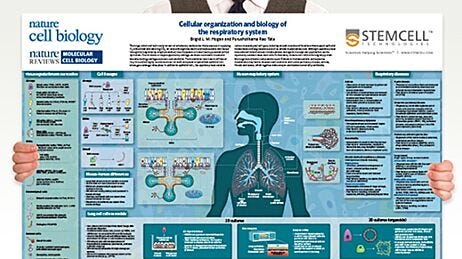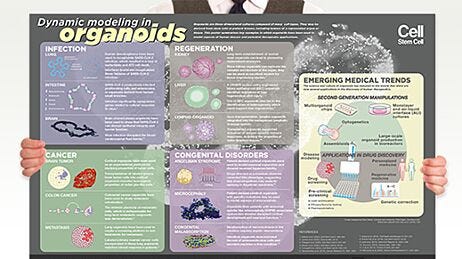Frequently Asked Questions on PneumaCult™ Apical-Out Airway Organoid Medium
Find answers to frequently asked questions (FAQs) about culturing human apical-out airway organoids using the PneumaCult™ Apical-Out Airway Organoid Medium.
Can't find the answer you’re looking for? Fill out our short form and our pulmonary specialists will get back to you.
General Information
What sample types are compatible with the PneumaCult™ Apical-Out Airway Organoid Medium?
We have successfully tested commercially available human bronchial epithelial cells (HBECs) from normal donors (i.e. Lonza Cat #CC-2540S, Epithelix Cat #EP51AB) with the PneumaCult™ Apical-Out Airway Organoid Medium. We have not tested HBECs isolated directly from primary tissue, but they should be compatible.
Unsure which culture media to choose? Try our interactive product finder to find the right media for your pulmonary research >
Learn more about PneumaCult™ Culture Media for Airway Epithelial Cells and Pulmonary Organoids.
Is the PneumaCult™ Apical-Out Airway Organoid Medium compatible with HBECs derived from other upper airway regions?
PneumaCult™ Apical-Out Airway Organoid Medium was not optimized with nasal cells, however, they may be compatible.
Is the PneumaCult™ Apical-Out Airway Organoid Medium serum-free and BPE-free?
Does the PneumaCult™ Apical-Out Airway Organoid Medium require a Matrigel® Matrix or Transwell® inserts?
No, HBECs are differentiated into apical-out airway organoids using a Transwell®-free and Matrigel®-free system.
The PneumaCult™ Apical-Out Airway Organoid Medium technology has been published. Differentiated apical-out airway organoids are susceptible to infection with common respiratory viruses and inhibition of viral replication by antivirals.
- Stroulios G., et al. (2022) Apical-out airway organoids as a platform for studying viral infections and screening for antiviral drugs. Scientific Reports 12: 7673.
What is the distribution of airway cell types after differentiation using the PneumaCult™ Apical-Out Airway Organoid Medium?
Day 15 apical-out airway organoids cultured in PneumaCult™ Apical-Out Airway Organoid Medium contain cells with beating cilia on the outward-facing apical cell surface with a cell-dense core containing basal cells.
Is there a limit for the HBEC passage number during expansion, prior to differentiation using the PneumaCult™ Apical-Out Airway Organoid Medium?
PneumaCult™ Apical-Out Airway Organoid Medium allows for the initiation of apical-out airway organoids using passage 7 - 8 HBECs from normal donors (i.e. Lonza Cat #CC-2540S, Epithelix Cat #EP51AB) and when expanded using PneumaCult™-Ex Plus Medium. The limit for HBECs to successfully differentiate after long-term passaging is determined by the quality of the donor and the medium used for basal cell expansion.
Can different cultureware be used for the PneumaCult™ Apical-Out Airway Organoid Medium protocol?
For the initial aggregation phase, the PneumaCult™ Apical-Out Airway Organoid Medium protocol was optimized using AggreWell™400 24-well plates, however, AggreWell™400 6-well plates can also be used.
For the subsequent 9-14 day differentiation suspension culture, the kit was optimized using tissue culture-treated Costar® 24-Well Flat-Bottom Plate. Culture plates of different formats can also be used, following treatment with the Anti-Adherence Rinsing Solution, and adjusting the media volume and aggregate numbers proportionally. After the removal of the Anti-Adherence Rinsing Solution, ensure each well has been washed with room temperature DMEM/F-12 with 15 mM HEPES. The use of D-PBS for performing washes is not recommended as it has a detrimental effect on the organoid structure.
Approximately how many apical-out airway organoids are expected at the end of the 14-day suspension culture?
Approximately 200-800 organoids can be generated from one well of an AggreWell™400 24-well plate, with HBECs of lower passages yielding more organoids and those of higher passages yielding fewer organoids.
How many days can organoids generated using the PneumaCult™ Apical-Out Airway Organoid Medium remain in the differentiation phase?
We find that the optimal time point for characterization or downstream applications for the apical-out airway organoids is between Days 15 - 25 of the differentiation protocol. Some selection (increased cell death) and morphological changes may be observed at 30 days, but depending on the donor, it may be possible to maintain the organoids for a longer period (<3 months).
Pulmonary Organoids Learning Center
Learn about using an organoid culture system for in vitro lung modeling with this collection of protocols, webinars, and other scientific resources.
Setup and Culture
What is the suggested 2D expansion medium used to maintain HBECs prior to undergoing the PneumaCult™ Apical-Out Airway Organoid differentiation protocol?
The PneumaCult™ Apical-Out Airway Organoid Medium was optimized using PneumaCult™-Ex Plus Medium, which is the expansion medium we suggest. As per the PneumaCult™-Ex Plus protocol, once cells are approximately 50 - 60% confluent they are ready to be passaged. Expansion of HBEC cultures in PneumaCult™-Ex Plus should not be overly confluent as cells will senesce and be detrimental to the aggregate structure. We suggest using air-liquid interface-qualified HBECs for the most robust performance.
Why is there a donor optimization step on the Product Information Sheet?
This step is required for optimizing the aggregation time in the AggreWell™400 24-well plate in order to maximize efficiency by reducing aggregate fusion and should be performed for each separate donor. The aggregation time is often 24 hours but can take up to 6 days. Aggregates are then transferred into the suspension cultures using tissue culture-treated 24-well flat-bottom plates and incubated at 37°C and 5% CO2 for 24 hours. If no fusion between aggregates is observed in the suspension culture, proceed with the protocol. If fusion between aggregates is observed, increase the aggregation time in the AggreWell™400 plate until fusion between aggregates is no longer observed.
Why is the complete differentiation protocol not performed in AggreWell™ plates?
Are AggreWell™400 6-well plates compatible with the aggregation phase?
Yes, however, slightly different size distributions are observed between the 6- and 24-well AggreWell™400 plate formats. As a result, the outer microwells may display more debris and have less efficient aggregate formation compared to a microwell in the center of the well.
During differentiation, there are many dead cells accumulating in the suspension cultures in the 24-well flat-bottom plate. Is this normal?
Some cell death may be observed during the suspension phase. Please ensure that the correct seeding density has been followed for the aggregation phase in the AggreWell™400 plate, using viable HBECs. Overseeding cells may result in the shedding of cells into the surrounding medium.
Is the Anti-Adherence Rinsing Solution a required step for pre-treating plates and plasticware?
Plates must be pre-treated using Anti-Adherence Rinsing Solution which prevents cell adhesion and promotes efficient aggregate formation. This includes the AggreWell™400 24-well plates and tissue-culture-treated Costar® 24-Well Flat-Bottom Plates. All treated plastics should be thoroughly washed with DMEM/F-12 following the coating procedure. Coating of tubes and pipettes with the Anti-Adherence Rinsing Solution is optional and might benefit donors with low differentiation efficiency, however, this is not a crucial step.
How should the washing steps be performed for downstream applications following the differentiation protocol?
If downstream applications include washing steps, perform all organoid washes in DMEM/F-12 warmed to room temperature. We do not recommend washing organoids with D-PBS as it has a detrimental effect on the structure.
For full protocol details please refer to the Product Information Sheet under the Protocols and Documentation tab on the PneumaCult™ Apical-Out Airway Organoid Medium product page.
Cryopreservation and Passaging
Is it possible to seed HBECs directly from cryopreservation into the AggreWell™400 plates to initiate the aggregation phase?
We would recommend passaging HBECs post-thaw at least once in PneumaCult™-Ex Plus before initiating the aggregation phase.
Can organoids generated using the PneumaCult™ Apical-Out Airway Medium be cryopreserved?
We have not tested cryopreservation of the apical-out airway organoids.
Can organoids generated using the PneumaCult™ Apical-Out Airway Medium be passaged at the end of the culture period?
Apical-out airway organoids contain many terminally differentiated cells, therefore, passaging is not recommended.
Applications
Do we offer a protocol for the immunocytochemical (ICC) staining of organoids generated using the PneumaCult™ Apical-Out Airway Medium?
The technical protocol Performing Immunocytochemical Staining of Epithelial Organoids describes a detailed whole-mount ICC staining protocol for epithelial organoids. See Table 1 below for recommended antibodies.
Table 1. Recommended Antibodies for ICC staining
| Antibody | Catalog # |
|---|---|
| Acetylated Tubulin | e.g. Sigma-Aldrich, T7451 |
| MUC5AC | e.g. Abcam, ab212636 |
| ZO-1 | e.g. Thermo, 339188 |
| KERATIN 5 | e.g. Biolegend, 905501 |
Do we offer an RNA isolation protocol from organoids generated using the PneumaCult™ Apical-Out Airway Medium?
The technical protocol How to Process Epithelial Organoids and Organoid-Derived Epithelial Monolayers for RNA Isolation describes a method for processing epithelial organoids for RNA extraction. See Stroulios G., et al, Sci Rep, 2022 Table 1 for the accession number of assays used to characterize apical-out airway organoids.
How can apical-out airway organoids be dissociated to measure ciliated cell counts?
Differentiated apical-out airway organoids can be harvested on Day 15, transferred to a 15 ml tube, and centrifuged at 150 g for 5 minutes. Organoids can be washed once with DMEM/F-12, resuspended in TrypLE Express, and incubated for 5 - 7 minutes at room temperature, before being dissociated to single cells by pipetting vigorously with a P1000 pipette. Incubation can be extended for 2-5 minutes if the tube contains large clumps of cells following observation under the microscope. A 30 µl aliquot of the single-cell suspension can be diluted 1:1 with Trypan Blue, loaded onto a hemocytometer, and counted manually.
Try PneumaCult™ Media for Respiratory Research
Request information about introductory offers to try PneumaCult™ Media in your own lab.
Characterization
Can organoids differentiated using the PneumaCult™ Apical-Out Airway Medium be dissociated and seeded onto Transwell® inserts for a 2D system?
The PneumaCult™ Apical-Out Airway organoid system is an endpoint assay for downstream applications. For the culture and differentiation of HBECs at 2D on Transwell® inserts, we recommend using the PneumaCult™-ALI Medium system.
Are organoids differentiated using the PneumaCult™ Apical-Out Airway Medium suitable for viral infection studies?
We have shown that PneumaCult™ Apical-Out Airway organoids are susceptible to infection with common respiratory viruses and show varying responses upon treatment with antivirals.2
Can organoids differentiated using the PneumaCult™ Apical-Out Airway Medium be used to study SARS-CoV-2 infection models?
PneumaCult™ Apical-Out Airway organoids can be used to study viral infectious diseases.2 We have not tested SARS-CoV-2 infection in-house but collaborator laboratories have reported successful infection of the organoids with the SARS-CoV-2 virus. ACE2 immunostaining has been observed on the apical surface of the apical-out airway organoids.
Can organoids differentiated using the PneumaCult™ Apical-Out Airway Medium be microinjected?
When fully differentiated, PneumaCult™ Apical-Out Airway organoids usually exhibit little-to-no lumen surrounded by a polarized epithelium and, as such, cannot be microinjected.
Are organoids differentiated using the PneumaCult™ Apical-Out Airway Medium amenable to the forskolin-induced swelling assay?
PneumaCult™ Apical-Out Airway organoids usually do not contain a lumen and are likely not sensitive to the forskolin-induced swelling assay. Chloride ions exit the cell via the apically located CFTR chloride channel, as such, swelling will occur when organoids contain apical cells facing inwards (i.e. such as those generated using the PneumaCult™ Airway Organoid Kit). Due to the established polarity, apical-out airway organoids would be expected to shrink, yet their dense structure will likely render the measurement of the effects challenging.
Apical-in airway organoids can be generated using the PneumaCult™ Airway Organoid Kit.
Do organoids differentiated using the PneumaCult™ Apical-Out Airway Medium have the potential for high-throughput applications?
Apical-out airway organoids are cultured in suspension and can be easily adapted to different-sized cultureware such as 96-well plates.
See Figure 4 in the PneumaCult™ Apical-Out Airway Organoid Medium product page to view the results of scaling up production without compromising the quality and functionality of the airway organoids for high-throughput applications.
Related Resources
References
- Bluhmki T et al. (2020) Development of a miniaturized 96-Transwell air–liquid interface human small airway epithelial model. Sci Rep 10(1):13022.
- Stroulios, G. et al. (2022) Apical-out airway organoids as a platform for studying viral infections and screening for antiviral drugs. Sci Rep 12: 7673.
Request Pricing
Thank you for your interest in this product. Please provide us with your contact information and your local representative will contact you with a customized quote. Where appropriate, they can also assist you with a(n):
Estimated delivery time for your area
Product sample or exclusive offer
In-lab demonstration








